September 12, 2014
Air Date: September 12, 2014
FULL SHOW
SEGMENTS

Prosecutor Defends Climate Action Civil Disobedience
View the page for this story
In a surprise move, Massachusetts DA Samuel Sutter dropped criminal charges against climate activists who used a lobster boat to block a freighter carrying 40,000 tons of coal from reaching the Brayton Point power plant. Blockader Jay O’Hara speaks with host Steve Curwood about the action, the legal argument for the protest and why the climate crisis makes civil disobedience necessary. (11:05)
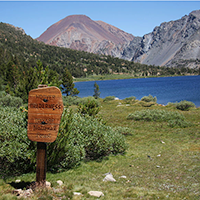
Wilderness Act at 50
View the page for this story
This month marks the 50th anniversary of the Wilderness Act. Host Steve Curwood and American environmental writer Jordan Fisher Smith discuss the relevance of the Wilderness Act today, and changing perceptions of wild lands, their uses and how to protect them. and. (09:20)
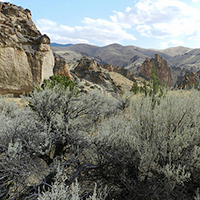
A Fight for New Wilderness
/ Cassandra ProfitaView the page for this story
Despite the 1964 Wilderness Act, Congress, local opposition and special interest groups are making it increasingly difficult to protect wild areas from development. Still, as Cassandra Profita from EarthFix reports, individuals continue to fight for wilderness designation. (05:00)

Beyond the Headlines
/ Peter DykstraView the page for this story
In this week’s trip beyond the headlines, Peter Dykstra tells host Steve Curwood about how living near green spaces positively impacts newborns’ birthweight, a reporter’s problems in obtaining information on an invasive algae known as “rock snot” from the Canadian government, and remembers 1999’s Hurricane Floyd and the Hog Waste Crisis. (04:00)
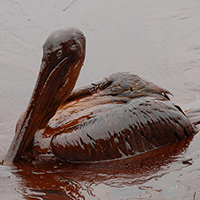
British Petroleum Guilty of Gross Negligence
View the page for this story
A Louisisan judge has ruled that BP acted with gross negligence in the lead-up to the 2010 Deepwater Horizon oil disaster. This means he oil giant may have to pay as much as $18 billion dollars in additional fines. Host Steve Curwood discusses what the verdict means and what the next legal steps are with Vermont Law School's Peter Parenteau. (09:00)
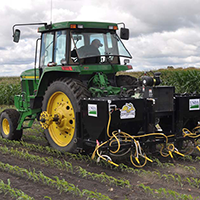
Organic-Friendly Weed Blaster
View the page for this story
Researchers at the USDA have developed new technology to combat weeds on organic farms. Host Steve Curwood talks with agronomist Frank Forcella about how he modified the common sand blaster to simultaneously fertilize and weed food crops. (06:55)
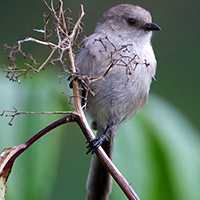
BirdNote® Bushtit - A Very Tiny Songbird
/ Mary McCannView the page for this story
Mary McCann observes sprightly bushtits as they hang upside-down from branches to feed on insects under leaves and tweet constantly as they fly in sizeable flocks from bush to bush. (01:55)
Show Credits and Funders
Show Transcript
HOST: Steve Curwood
Guests: Jay O’Hara, Jordan Fisher Smith, Pat Parenteau, Frank Forcella
Reporters: Cassandra Profita, Peter Dykstra, Mary McCann
[THEME]
CURWOOD: From Public Radio International, this is Living on Earth.
[THEME]
CURWOOD: I'm Steve Curwood. A Massachusetts prosecutor drops criminal charges against activists who blocked a huge freighter trying to deliver coal to a power plant as an act of civil disobedience in defense of the climate.
O'HARA: The governor here in Massachusetts has said, he doesn't think it’s the appropriate role of the governor to shut down private businesses. Well, if private businesses are causing the end of civilization, who then should be responsible for that? District Attorney Sutter stepped out on a limb, in a way he didn't have to, to say the political system isn't capable of dealing with this problem right now, and essentially calling on further civil disobedience to raise this issue.
CURWOOD: Why a law enforcement leader is urging activists to break the law. Also, the Wilderness Act is fifty years old. It's going strong, but also showing its age in today’s world. We’ll have that and more this week on Living on Earth. Stick around.
[NEWSBREAK MUSIC: Boards Of Canada “Zoetrope” from “In A Beautiful Place Out In The Country” (Warp Records 2000)]
ANNOUNCER: Support for Living on Earth comes from United Technologies – innovating to make the world a better, more sustainable place to live.
Prosecutor Defends Climate Action Civil Disobedience
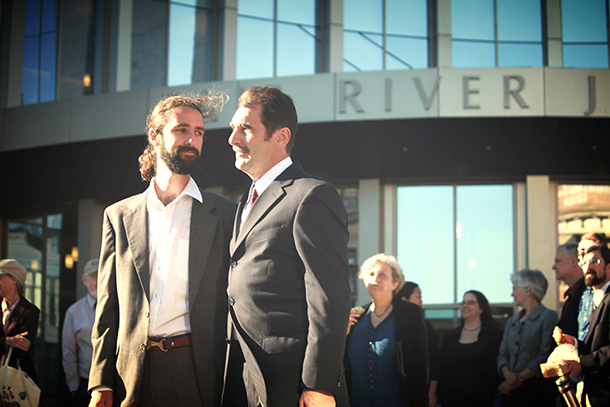
Climate activists Jay O’Hara and Ken Ward outside the courthouse in Fall River, MA (Photo: Kate Toomey; CC BY 2.0)
CURWOOD: From the Jennifer and Ted Stanley Studios in Boston and PRI, this is Living on Earth. I’m Steve Curwood. Climate activists are celebrating an unlikely hero, Samuel Sutter, the District Attorney of Bristol County, Massachusetts. On September 8th, DA Sutter dropped all criminal charges against two men who, back in May, used a small lobster boat - aptly named the Henry David T - to block a shipment of coal headed to the Brayton Point power plant in Somerset. Instead, the prosecutor accepted the argument of the two activists, Jay O’Hara and Ken Ward, that the risks of global warming compelled their act of civil disobedience —something Jay O’Hara only learned the morning he and his colleague were scheduled to go on trial.
O’HARA: We had been hearing kind of rumors from the prosecutor since Friday, but they hadn’t come to any conclusion until Monday morning. We were waiting diligently in court at the appointed hour, and the prosecutor came in, and shortly thereafter the District Attorney came in. And it was clear from that moment that it wasn’t going to be a normal trial proceeding that morning.

The Energy Enterprise was carrying 40,000 tons of coal bound for the Brayton Point power plant in Massachusetts. (Photo: Lobster Boat Blockade)
CURWOOD: No, indeed. And on the courthouse steps DA Samuel Sutter explained the legal thinking to the crowds.
SUTTER: The decision that Robert Kidd and I, that’s the Assistant District Attorney who handled this case, reached today was a decision that certainly took into consideration the cost to the taxpayers in Somerset, but was made with our concern for their children, the children of Bristol County and beyond in mind. Climate change is one of the gravest crises our planet has ever faced.
CURWOOD: Activist Jay O’Hara told us his story when he came by our studio.
O'HARA: You know, I’m a Quaker, and so I try to open myself to whatever comes, and I've been really detached from whatever the outcome is. I wasn't clear what was the right or the best outcome, and every step along the way of this, right from the beginning, planning the action through doing the action, we kept finding that new, unexpected things ended up turning out in interesting and better ways than we ever could have planned. And so this seemed like just another one of them. The roll continues.
CURWOOD: What did you have to pay in terms of fines here?
O'HARA: Well, we actually didn't technically have to pay fines. The finding was, we were found responsible and asked to pay $2,000 restitution to the Somerset police and the state police for their overtime charges essentially.
CURWOOD: So this was not a penalty, this was not criminal then; this was civil?
O'HARA: Correct. Right.
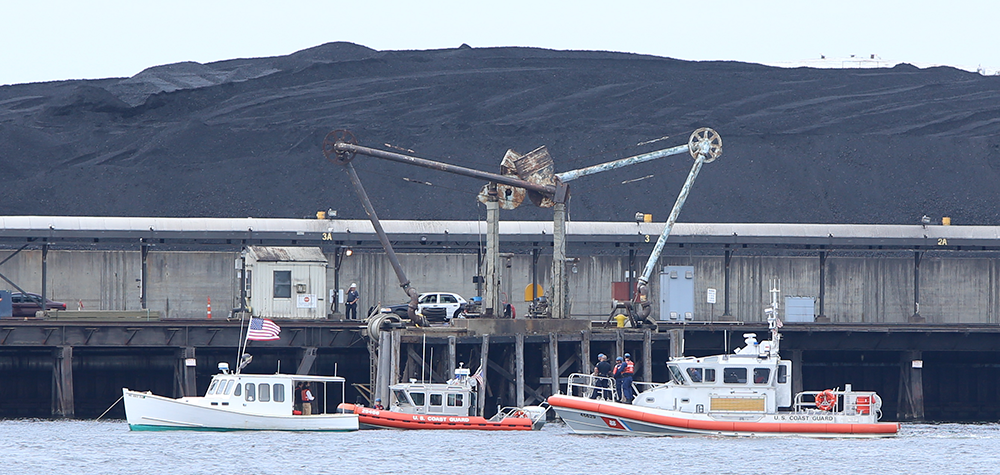
The Henry David T surrounded by Coast Guard boats with the coal ship in the background (Photo: Lobster Boat Blockade)
CURWOOD: You were inconvenient for those police.
O'HARA: Fortunately I think we were more inconvenient for the Energy Enterprise, the ship that was trying to dock, which was our intention. We really had no interest in being inconvenient for the police, but they showed up, and I think we owed them some of the money to deal with that.
CURWOOD: So take us back to the action itself. How did this all come about? How did you and your partner, not in crime, but in civil disobedience, Ken Ward, decide to this?
O'HARA: I had been working for a while here in the climate movement in Massachusetts, and the response we were getting, from either legislation that was introduced or policies that were proposed, it was clear that those policies were never going to reach the demands of the science. And we were never going to get the sort of dramatic emissions reduction that the science demands.
After a period of searching for what the right thing to do was, I felt really kind of clear that it was time to do something that showed viscerally how the problem is connected to the burning of coal and to put myself in the middle of that process: the shipment to the burning. And Ken, for his own reasons, had been thinking along similar lines, and we kind of came to this independently. And there was one night in the fall of 2012 when Scott Brown and Elizabeth Warren were running for the Senate here in Massachusetts, and they had had two debates, and hadn't mentioned climate at all. And we were vigiling 24 hours a day at the Government Center here in Boston to get them to talk about climate. Ken showed up at three in the morning with some hot cider on a rainy day on the eve of Hurricane Sandy bearing down on New England and New York, and said, "Jay, I have an idea. Why don't we get a boat and block the ship at Brayton Point?" And my heart just kind of just leapt for joy. It was clear that this was the work for me to do.
CURWOOD: You have this lobster boat called the Henry David T...I mean, was that the name of the boat before you embarked on this?
O'HARA: We did rename the boat. We'll confess to that. Yes.
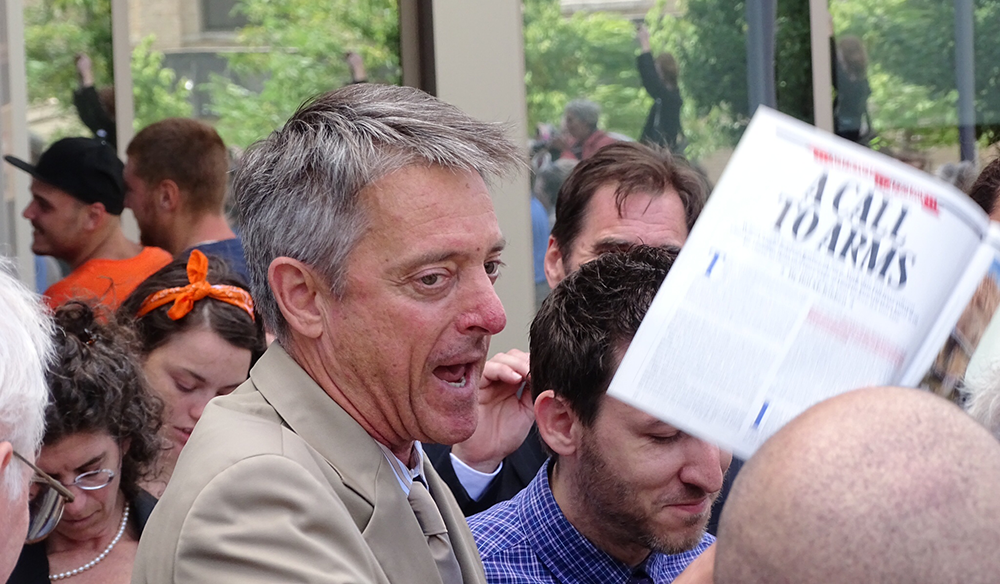
During his press conference, District Attorney Samuel Sutter holds up a copy of an article by writer Bill McKibben. (Photo: Peter Bowden)
CURWOOD: OK. So tell me, what happened on that day?
O'HARA: We had spent the night in Newport, Rhode Island. We woke up really early, and at 6 a.m. just before sunrise, we were on the dock for a short prayer meeting. We got on the Henry David T and motored north through Narragansett Bay under a cloudless sky on a windless day. It was absolutely beautiful. And we had been tracking and were able to track, actually, online, the position of the ship, the Energy Enterprise, which was delivering these 40,000 tons of Appalachian mountaintop removal coal, and we could tell that it was going to be heading up the bay behind us. We motored up the bay and navigated our way into the Brayton Point ship channel. We dropped two anchors, one a pretty small standard anchor and one very large heavy one that was chained to the keel of our boat, making us essentially an immovable block between the incoming ship and the pier where it intended to unload its coal. But before the ship ended up bearing down on us, the coast guard arrived. They boarded our boat, and while they were on board the boat, the tugboats and the others who were assisting the ship to come actually came in and half-moored the boat; they kind of put it on the pier, but in a place where they couldn't unload their coal. They weren't in any danger. They were kind of safely tied up, but the bow of this enormous ship was towering over us only maybe 200 feet away. And it was a pretty impressive hulk looking up over it.
CURWOOD: Now, what did the Coast Guard or anybody know about this civil obedience before you did it? Did you give them a heads-up: we're going to be out there.
O'HARA: We did. Through this whole process, our intention is to be absolutely transparent. Once we dropped anchor the first thing we did was call the town of Somerset police department and let them know that we were conducting a nonviolent peaceful protest and that our intentions were to remain in the ship channel. We had a couple of conversations with them. I spoke with the captain of the coal ship on the VHF radio, on the marine radio, so everyone was very clear about our intentions.
CURWOOD: What did you tell the captain? You said, "Ahoy here, this is the Henry David T and then...?"

Jay O’Hara (L) with activist Tim DeChristopher, who was jailed for 21 months for protesting oil and gas leasing on 22,000 acres of federal land. (Photo: Peter Bowden)
O'HARA: Well, the most amazing part of that conversation was that the captain couldn't quite understand what we were talking about, that we were, with some incredulity he asked, "but this is American coal", as if the protest was about the nationality of the coal or our energy sources, when in fact I was able to reply, "it's actually about the coal itself and the climate crisis that it's bringing on us." And I wouldn't even call this civil disobedience; what we really did was direct action. We put ourselves in a place where our bodies were physically preventing the harm that is happening, and the harm is the burning of fossil fuels.
CURWOOD: So what happened in the end? To what extent do you feel you able to stop this shipment?
O'HARA: We were ordered to leave by the Coast Guard and threatened with enormous penalties had we not left. And we ended up, after hours of trying to literally raise the anchor by ourselves, which proved impossible, hiring a salvage company under Coast Guard order to remove the 200-pound anchor, and we left on our own power, knowing that there would be charges to follow.
CURWOOD: So nobody arrested you.
O'HARA: We were never arrested, never detained.
CURWOOD: But you were charged, and they were pretty serious charges I gather. What exactly were they?
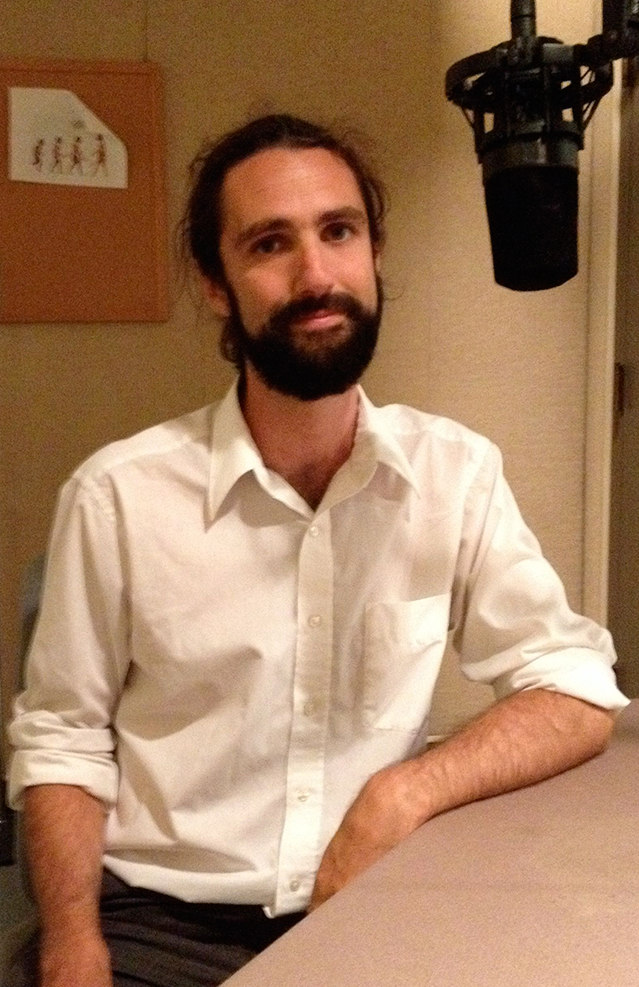
Jay O’Hara in the Living on Earth studio (Photo: Steve Curwood)
O'HARA: We had a charge of felony conspiracy to commit a crime. We had a charge of disturbing the peace. We had a charge of negligent operation of a motor vessel and failure to act to avoid a collision, much of which we were prepared to fight in court, but more importantly, in court, what we were looking to do was to give what is classically known in the common law as a necessity defense, saying that our actions—while they may have broken some laws, given the threat to public safety and public well-being—are necessary to prevent that greater harm.
CURWOOD: It's like saying, “well, I went the wrong way on the one-way street to help put out the fire”.
O'HARA: Yeah, or “I jaywalked to make sure the person wasn't hit by the car”.
CURWOOD: How prepared were you to go to jail?
O'HARA: I felt very clear that if I was sentenced by a...or if I was convicted by a jury of my peers that I was ready and prepared to face the consequences of my action, knowing that that sort of commitment is the sort of commitment that changes hearts when people see other people put their lives on the line for something that really matters—put their lives on the line for the truth, people's hearts changed. And I think that's exactly what happened with the district attorney. He saw two guys who put, maybe not their money but at least their bodies, where their mouth was and that inspired him to come out and say, hey, this is a huge problem, and more of us need to get on board with it.
CURWOOD: So all in all, what's the significance of this ruling and your action in terms of the broader climate movement, do you think?
O'HARA: I think that remains to be seen. While we were only able to stop the shipment for 12 hours, I think that was a pretty big victory. The thing about direct action, which helps stop these problems, is that it inspires people because they see the moral clarity of the act and the moral depravity of the way business as usual is conducted. And just a couple of months later in July, there were over 300 people rallying at the gates of the plant with dozens risking arrest to show their commitment to shutting down the burning of coal in Massachusetts, as well as there was a subsequent march in August and then eventually later that fall, the plant's owners announced its intended closure by 2017.
CURWOOD: September 21st in New York City, a lot of climate activists are coming together to have what they hope/pray will be the biggest climate demonstration ever in this country. What's next for you: plans to join that rally? I gather the District Attorney Samuel Sutter is going to be there as well.
O'HARA: That's exactly what he said yesterday, that he plans to be there in New York. I plan to be there, and I know hundreds and hundreds of other people from all over are planning to be there. Thousands and maybe even a million people will be there. My partner and I are going to be sailing our sailboat from Fall River where the trial was, down Long Island Sound and meeting with and talking with interfaith groups concerned with climate change on the way to New York, getting ready for that big rally. But for me, showing up to the rally is important, but it's not in any way the endgame. The endgame is when we start to turn our whole lives over to living in according with this truth. And I know, I trust that there are hundreds, maybe thousands of people across the country, who are ready to put that commitment into action and I'm looking forward to seeing what comes.
CURWOOD: Jay O'Hara and his colleague Ken Ward successfully used a necessity defense to argue that climate change compelled their act of civil disobedience, blocking a coal ship from landing at Brayton Point, Massachusetts. Thanks so much for coming by the studio today, Jay.
O'HARA: Thanks so much Steve. It was a pleasure.
Related link:
The Blockaders Website
[MUSIC: John McCutcheon from “Dallas Rag” from The Wind That Shakes The Barley (Rounder Records 2000)]
CURWOOD: Coming up: America’s Wilderness Act at 50. That’s just ahead. Stay tuned.
[CUTAWAY MUSIC: Miles Davis with the Gil Evans Orchestra from “Summertime” from Porgy and Bess (Columbia 1959)]
Wilderness Act at 50
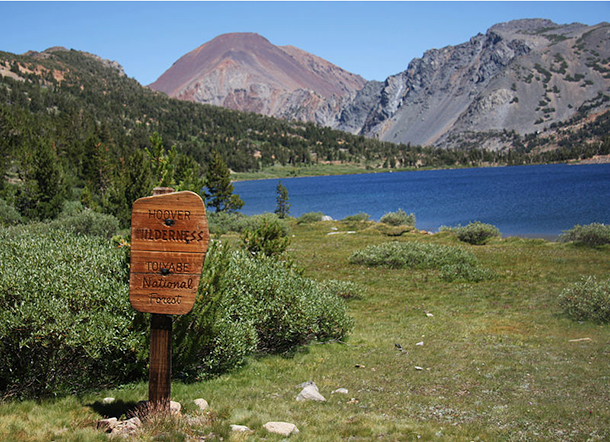
The Hoover Wilderness sign at Summit Lake. The Hoover Wilderness spans 128,000 acres and is managed by the Inyo National Forest and the Humboldt/Toiyabe National Forest mostly in northern California and Nevada. (Photo: Dcrjsr; Wikimedia Commons CC-BY-SA-3.0)
CURWOOD: It's Living on Earth. I'm Steve Curwood. Fifty year olds can be in their prime, brimming with vigor, confidence and mastery. Of course, they can also be showing their age with some fraying at the edges. Well, one of America’s key conservation laws, the Wilderness Act, is celebrating its 50th birthday this month. Writing in Orion Magazine, former park ranger Jordan Fisher Smith argues that the law is both vigorous and competent, and a little threadbare. We first spoke to Jordan Fisher Smith in 2005 about his memoir, Nature Noir: A Park Ranger’s Patrol in the Sierra. Welcome back to Living on Earth, Jordan.
SMITH: Well, thanks. It’s great to be with you again.
CURWOOD: First, how is wilderness defined in the Wilderness Act?
SMITH: The definition of wilderness in the 1964 Wilderness act is that it's "an area where the Earth and its community of life are untrammeled by man, where man himself is a visitor and does not remain". It's further defined as, "a place without permanent improvements or human habitation, which is protected and managed so as to preserve its natural…" and I'm underlining that word "…conditions."
CURWOOD: Now your article is called "The Wilderness Paradox". What's the paradox that you're referring to?

Scapegoat Wilderness was created by Congress in 1972 in the Helena National Forest, Montana (Photo: U.S. Forest Service Northern Region; Flickr CC)
SMITH: Well, you know it's right there in that definition I just gave you. This word "untrammelled" was a word that the principal author of the act, a guy named Howard Zahniser, thought very carefully about and used. A trammel is a piece of harness that is used apparently on horses to limit their movement, and “untrammeled” means that human beings have not controlled or in any way limited the behavior of nature and wilderness. But the second part of that definition I just gave you says that we're supposed to protect and manage it so as to preserve its natural conditions. Therein lies the paradox that I've written about. We are faced with a dilemma that in many wilderness areas in a time of climate change and mass extinction and defragmentation of landscapes, that many special and beautiful forms of life or valued natural conditions will not continue to exist without what we might say are “unnatural” human interventions.
CURWOOD: Now some have argued that the whole idea of American wilderness ignores the fact that Native Americans were living on this land and actively changing it for thousands of years before, you know, Aldo Leopold and John Muir and those folks came along.
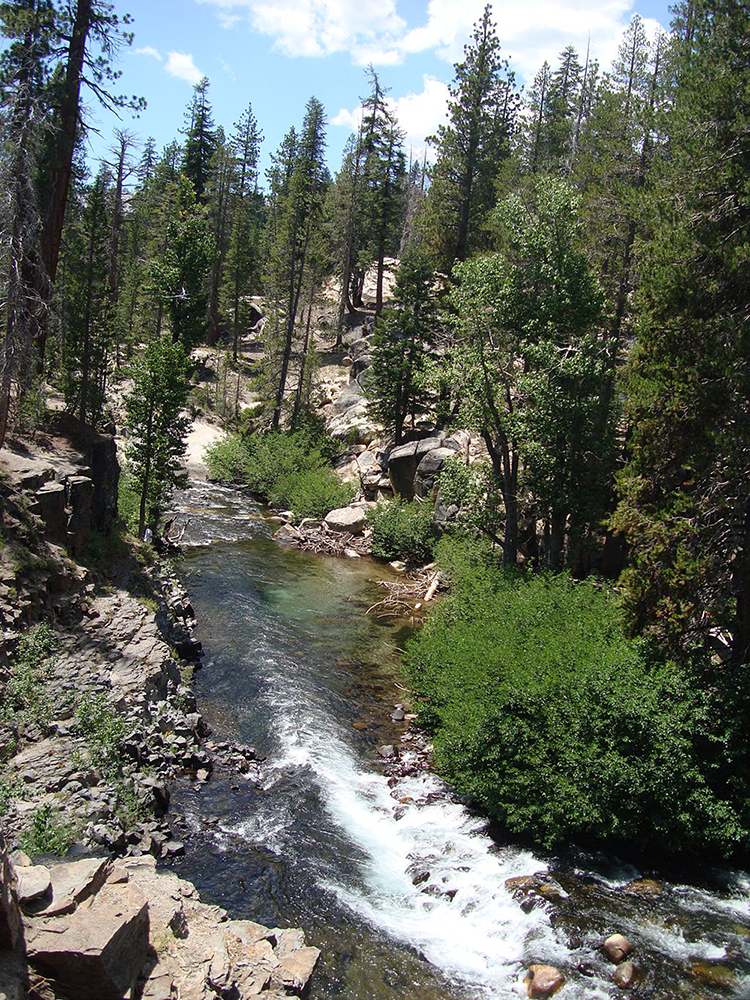
Originally called the Minarets Wilderness, the Ansel Adams Wilderness is located in the Sierra Nevada of California and was created in 1964. In 1984, the area was expanded and renamed in honor of Adams, an celebrated landscape photographer. (Photo: Eric T Gunther; Wikimedia Commons CC-BY-3.0)
SMITH: Yeah, I think that you can read that in this little line that says, "Where man himself is a visitor who does not remain". That's a piece of history there. That's a way that these people, at that time in 1964 thought of wilderness, as a place that you walk into alone with a backpack and nobody else is there, but you know I think we have to overlook the flaws in the Act and see the deep intention to reach for perpetuity and save what's really important about the beautiful flowering of life on Earth.
CURWOOD: So Jordan, you've traveled to a bunch of different wilderness areas for this piece, and of course, at other times. What are some of the ways in which park rangers, scientists and others are actively managing today's wilderness areas?
SMITH: Well, you know, among the most prominent ways that wilderness areas are constantly being managed is the continuing suppression of fire. We've now recognized that fire is good in the ecosystem; it performs a valuable role: It shapes landscapes and in fact, shaped the landscapes that we think are beautiful. But we have a hard time implementing it on the landscape. People have their whole career on the line if they let a fire go and it burns into a city, or it burns into a country town or burns down somebody’s summer cabin, and I think even increasingly now we're sort of backpedaling and putting them out, out of this fear that somebody will second-guess and end this bureaucrat’s career because they wanted to let fire do its work.
CURWOOD: And some other ways in which we actively manage wilderness these days?
SMITH: Well, this kind of intervention goes back to the beginning. Wildlife populations in particular have been manipulated in various ways, notably, originally the removal of predators. It caused in the 20th century, a bloom or an exaggeration of the numbers of prey species: species like deer in the east and the upper midwest, species like elk in the west. And biologists then noticed damage to plants and the species that these animals were eating. They then began literally shooting large numbers of wildlife. In the winter of 1961, ’62, Yellowstone National Park shot over 4,000 of its elk to try to protect its plants, and this goes on to the present day at places like Rocky Mountain National Park. And then now in some cases we're putting the predators back in, notably at Yellowstone, where there's been now a successful reintroduction of wolves and in central Idaho, in the wilderness I've written about in this piece, the Frank Church River of No Return.
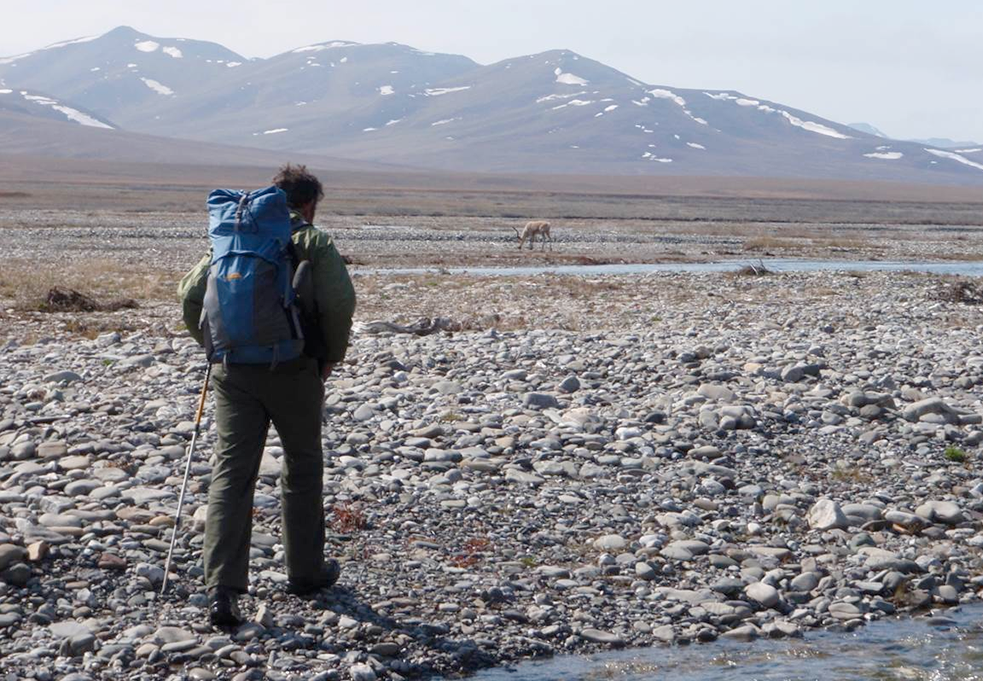
Jordan Fisher Smith looks on as caribou drink from a from a stream in the distance. (Photo: Courtesy of Jordan Fisher Smith)
CURWOOD: So in your article you describe some of the ways in which forest managers over the years have tried to curate wilderness experience for outdoor travelers. Talk to me about that, please.
SMITH: In the 1960s, with the growth of the environmental movement, with more leisure time and relative wealth in United States, there arose a kind of fervor for outdoor recreation, and people flooded into wilderness areas with backpacks, with canoes, and during that time, wilderness management really became people management. And an attempt was made to limit the number of people who might be in any given area at a given time so as to conserve or preserve the feeling of solitude that is mentioned in the Wilderness Act as a standard. And meanwhile in the background, all kinds of forest-wide and park-wide initiatives continued. For example, the Frank Church River of No Return saw widespread spraying of pesticides from aircraft for Spruce Budworm, a native insect that devegetates wild trees. This was an attempt, really, to preserve what was called the “wilderness experience” as a psychological or cultural entity, as opposed to actually working on or preserving the wilderness itself.
CURWOOD: So fifty years ago this month, the Wilderness Act goes into effect. Talk to me about the value of the concept of wilderness today.
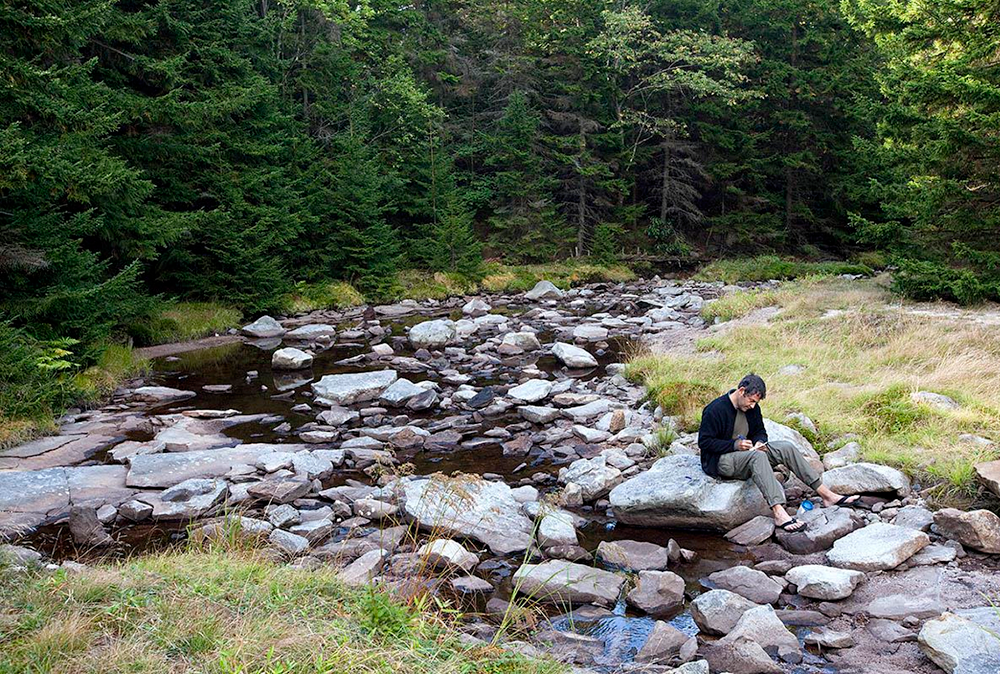
American nature writer Jordan Fisher Smith takes notes in the Okefenokee Wilderness of Georgia. (Photo: Courtesy of Jordan Fisher Smith)
SMITH: To me, the value of wilderness today is only greater than it was at the time of the 1964 act. From an ecological perspective, wilderness is a place for things that don't do well on farms or in cities or in suburbs. There are some plants and animals that we're familiar with that grow pretty well in a vacant lot in a suburb. Coyotes, for example, have done an amazing job of mixing with human beings, but there are species like Big Horn sheep, like Grizzly bears, like wolves, that just really don't mix well with human uses like agriculture, suburban development, freeways and so on, and wilderness is a critical place for the survival of these kind of species. A study released August 27th from researchers in three countries, found with a survey of 30 years of conservation studies that these protected areas like wilderness were doing what they should've done. There are more different kinds of species in them and there are greater numbers of plants and animals than in the lands around them that are given to other uses, so I think the value of wilderness is a kind of timelessness of its basic aim.
CURWOOD: The world has changed a lot since 1964, particularly the pace of climate change. What you think should be the guiding principles of wilderness managers today?
SMITH: Well, you know, that's a great question, and I don't know clearly the answer to that. Human beings have a way of manipulating and touching and moving everything around, and one of the things that distinguishes wilderness is that wilderness expresses it more and saves everything inside it. You're not really solving the problems that we have out in the world with how to get around without making carbon dioxide or how to heat our homes or make power. So wilderness was torn down as being irrelevant. Well, the fact is that wilderness is very relevant because it preserves the parts. Although Leopold says, you know, the first law of tinkering with a machine is: when you take a clock apart or an engine, you don't start throwing away the parts. And if we are going to restore the world and keep it going, we need all the pieces; we need to have all the plants and animals that we can save. But it's not just the pieces, it's how it works together. We can use these places to some extent, even though they're changing, as a blueprint of how nature works and we can look at them when we restore other places to health.
CURWOOD: Environmental writer Jordan Fisher Smith’s latest article is in Orion magazine. Thanks so much for taking time with us today.
SMITH: It was my pleasure. Thanks for your interest.
Related links:
- Read "The Wilderness Paradox" by Jordan Fisher Smith, published in this month's Orion Magazine
- Watch “Untrammeled”, a short film produced for the 50th Anniversary of the Wilderness Act.
- Visit Jordan Fisher Smith’s site
A Fight for New Wilderness
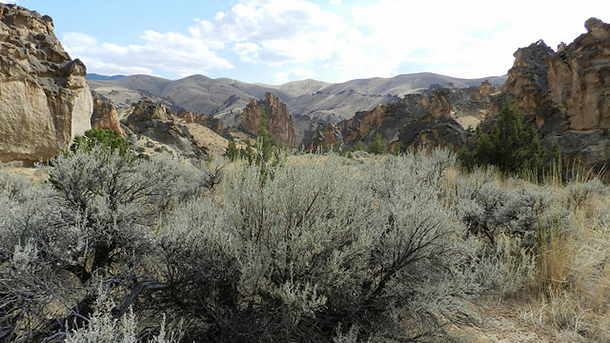
Oregon Natural Desert Association has proposed a 2.1 million acre wilderness area in the Owyhee Canyon lands, but it's a long way from congressional approval. (Photo: Cassandra Profita; EarthFix)
CURWOOD: So as it enters its second half-century, the Wilderness Act has to balance some competing demands. And it's harder to designate wilderness these days than it was back when America was fresh with all the questions about the future of nature raised by publication of Rachel Carson’s bestseller, Silent Spring.
Cassandra Profita from the public media collaboration EarthFix has this story from a proposed wilderness area in the southeast corner of Oregon.
HANSEN: Echo!
PROFITA: Chris Hansen calls out into a desert canyon in Southeast Oregon's Leslie Gulch.
HANSEN: Hello!
PROFITA: Nothing but the faint echo of his own voice calls back. The towering cliff walls surrounding him meet a sprawling expanse of sagebrush above. It's a rich reward for less than a mile of hiking.
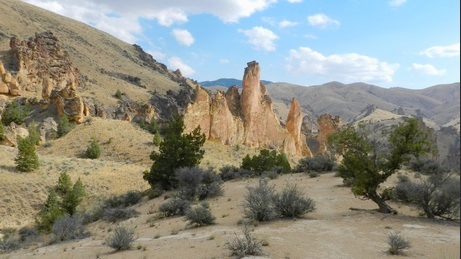
Locals in Oregon's Malheur County worry that a wilderness designation on the Owyhee canyon lands will close roads and restrict access to the land they love to explore. (Photo: Stephen Baboi; EarthFix)
HANSEN: You can see all these colors: Browns and rusts and greens and then mixed with the blue bunch on the hillside. It's just an awesome place to sit and look around and take in.
PROFITA: Hansen works with the environmental group Oregon Natural Desert Association. They put a wilderness designation on this canyon and 2 million acres of the public land surrounding the Owyhee River.
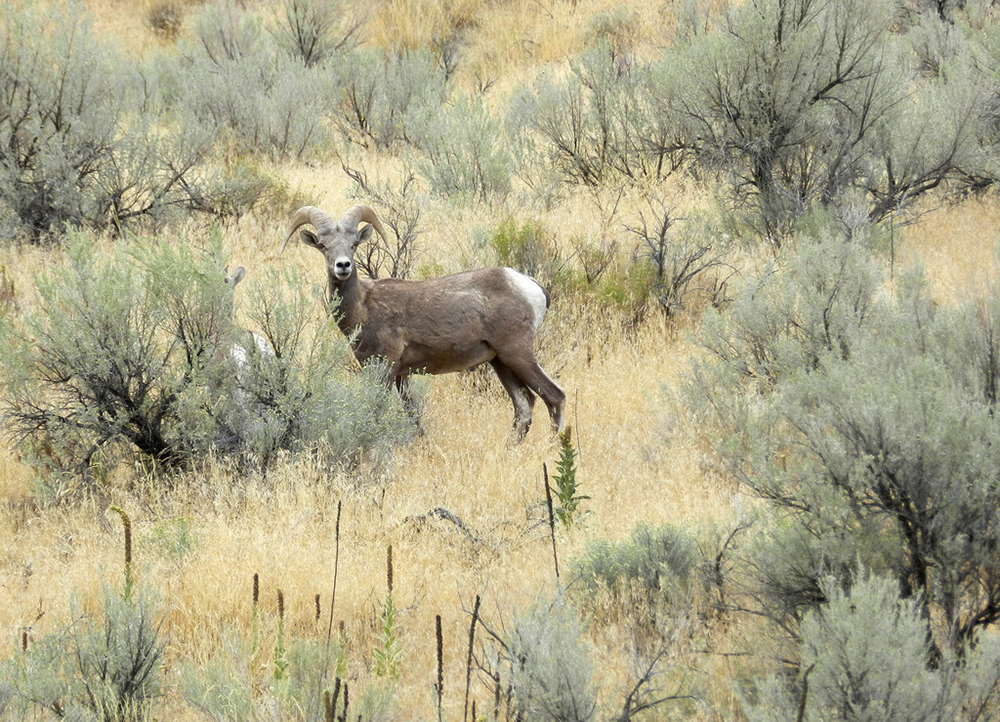
Bighorn Sheep in Owyhee country. (Photo: Cassandra Profita; EarthFix)
HANSEN: How could you not visit this place and say, “How is it not a national park? How is it not a place we haven't protected yet?”
PROFITA: But five years into the effort, a wilderness designation for the Owyhee Canyonlands still seems a long ways off. A committee formed by local leaders voted unanimously against the idea. And no one in Oregon's Congressional delegation has agreed to turn it into a wilderness bill. Congressional approval is required for wilderness designations, and that's hard to come by these days.
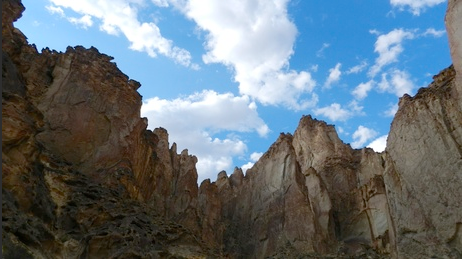
A short hike from a gravel road in southeast Oregon's Leslie Gulch road puts you in a steep-walled red rock amphitheater. It's just a sliver of the proposed 2.1 million-acre Owyhee Canyon lands wilderness. (Photo: Stephen Baboi; EarthFix)
ROWSOME: There are 33 current wilderness bills that are pending in this Congress.
PROFITA: Alan Rowsome is a policy advocate for the Wilderness Society. He says the rate of wilderness designation has dropped off in the last two decades. And now, it's at a near standstill.
ROWSOME: We have passed one wilderness bill through this Congress, but that's the only wilderness bill that has passed in the last five years since 2009.
PROFITA: Rowsome says finding new wilderness opportunities is a challenge as more of the country gets developed. Eighty five percent of the country’s wilderness was created before 1990. For places awaiting designation, getting wilderness bills through Congress is a bigger roadblock than it used to be.

Chris Hansen hikes through a gulch in the Owyhee. (Photo: Cassandra Profita; EarthFix)
WYDEN: It's definitely much, much harder.
PROFITA: Oregon Senator Ron Wyden says passing wilderness bills is harder, for one, because it's so easy for senators to block any bill.
WYDEN: And second, of course, there are powerful special interests, who often are lined up on the other side, and they'll say things like, "Oh, we don't need any more of these kinds of places. Oh, we already have enough of them."
PROFITA: But, he says, in his 30-plus years in Congress, it's never been easy to pass wilderness bills.
WYDEN: I don't know of a single wilderness bill that wasn't a very, very tough, hand-to-hand kind of battle.
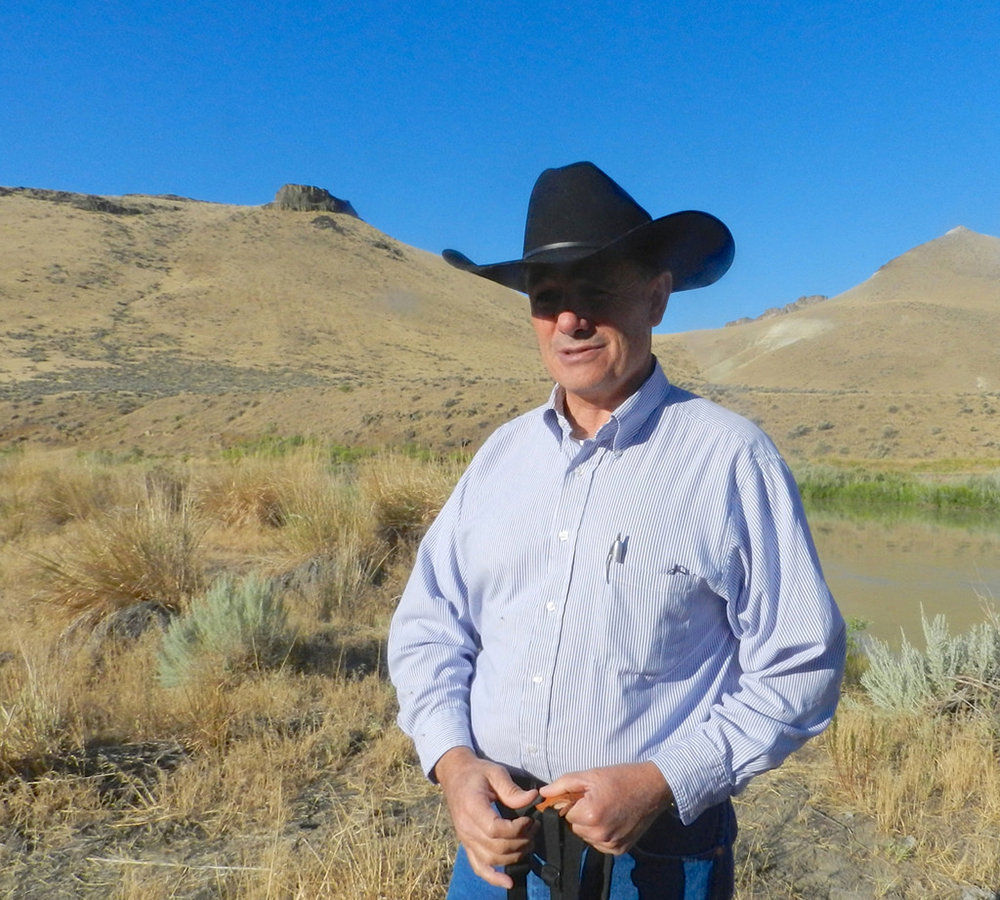
Malheur County Sheriff Brian Wolfe (Photo: Cassandra Profita; EarthFix)
PROFITA: In many places across the Northwest, the battle over wilderness starts long before the bill gets to Congress. With proposals including Washington's Olympic wilderness, Idaho's White Cloud wilderness and Oregon's Owyhee Canyonlands wilderness, the first fight is for local support.
[PLANE ENGINE STARTS]
PROFITA: Malheur County rancher Bob Skinner starts the engine of his airplane. He has more than a thousand cows spread out across his own land and some of the public land within the proposed Owyhee Canyonlands wilderness area. The landscape here is so vast and rugged, he flies a plane to check on the cows grazing on public land where he has a permit known as an allotment.
SKINNER: This is the south side of our allotment.
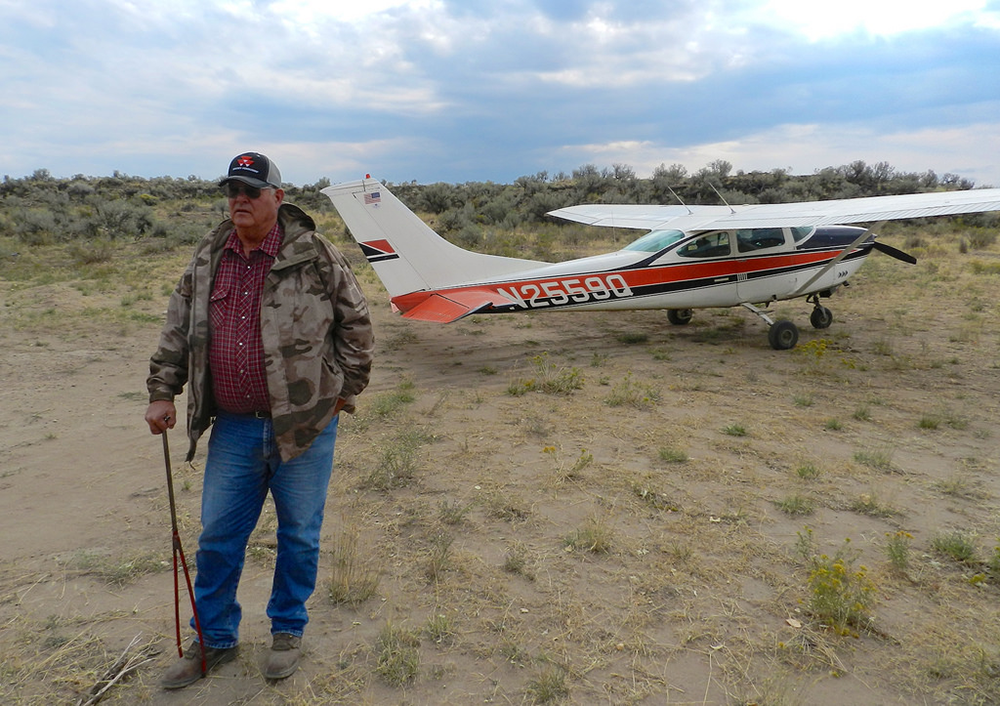
Rancher Bob Skinner (Photo: Stephen Baboi; EarthFix)
PROFITA: The plane offers a bird's eye view of the Owyhee's deep canyons and rolling desert. Skinner says that geography is protective enough. A wilderness designation is not only unnecessary, he says, but it could close roads that people need to fight wildfires and restrict ranchers from grazing.
SKINNER: You see all this? This will all be wilderness, and we're going to fight it for everything we're worth.
PROFITA: Local veterinarian Julie Weikel is on the other side of that fight. She's on the board of the Oregon Natural Desert Association, and she wants a wilderness designation to protect the Owyhee from things like oil and gas development and reckless ATV drivers.
WEIKEL: This is a chunk of country that's not too damaged yet. Because it's desert country, it can easily be harmed.

Veterinarian Julie Weikel Supports wilderness on the Owyhee. (Photo: Cassandra Profita; EarthFix)
PROFITA: And at 68, Weikel says, she doesn't want to wait too long to see it protected.
WEIKEL: I'd like to see this in my lifetime, darn it, for sure. I'd like to be able to tell my grandkids, yeah, I tried to help keep this place for you guys. Now take care it, darn it. I hope I get to tell them that.
PROFITA: Weikel says the Wilderness Act has done a good job of protecting special lands. But, she says, if that option takes too long or doesn't get enough local and political support, she'll be looking at other options. I'm Cassandra Profita reporting.
CURWOOD: Cassandra reports for the public media collaborative, Earthfix.
Related links:
- Read about the support for and against Wilderness bills on EarthFix’s website
- The 1964 Wilderness Act
[MUSIC: Bon Iver –“Lump Sum” from For Emma, Forever Ago (Jagjaguwar 2007)]
Beyond the Headlines

Higher birth weight is often equated with better health in newborns. (Photo: Charlotte; Flickr CC BY 2.0)
CURWOOD: Time now for a glimpse beyond the headlines with Peter Dykstra. He’s publisher of The Daily Climate.org and Environmental Health News: that’s EHN.org, and he’s on the line from Conyers, Georgia. Hi, Peter, what caught your fancy today?
DYKSTRA: Hi, Steve. We have a provocative study from the journal Environmental Health Perspectives. The study was done this summer by the University of British Columbia’s School of Public Health, and they took records of 64,000 births in the Vancouver area, plotted them out on a map and found that moms who lived near green space while pregnant had bigger babies and fewer premature births. The study also corrected for income factors.
CURWOOD: Wow, so bigger babies from homes near grass and trees?
DYKSTRA: Yeah, and it wasn’t a huge difference in birthweight, about 45 grams, which is, in turn, about an ounce and a half on average. There have been lots of studies on things that have a negative impact on birthweight, like air pollution and noise, but this report from British Columbia shows what might be a positive impact on newborns.

Green spaces have positive effects on expectant mothers, helping to increase birth weight and reduce premature births. (Photo: Victor; Flickr CC BY 2.0)
CURWOOD: It’s certainly nicer to look out on a park than a factory. OK, what else did you bring us this week?
DYKSTRA: We've got another story from Canada about when a reporter meets a bureaucracy while researching a story on something called “rock snot.” Can I say that on the radio?
CURWOOD: Uh, Peter, you just did.
DYKSTRA: Well, rock snot is the pet name for this gooey, invasive algae that’s become a nuisance when it grows on rocks in rivers and streams. Everybody can probably use their imaginations for what rock snot looks like and feels like. But a reporter for the Canadian Press wire service wanted to do a story on how it’s spreading, and that reporter reached out to Max Bothwell, the scientist who is the rock star of rock snot. Now Canada’s in the middle of a massive crackdown on public comments by its government scientist, so the interview never happened.

Rock snot, an invasive algae is spreading due to climate change. (Photo: teresatrimm; Flickr CC BY SA2.0)
CURWOOD: Yeah, we’ve reported on this information stonewall on government scientists in Canada, but it extends to rock snot as well? How come?
DYKSTRA: Well, it’s believed that rock snot is spreading due to climate change, and Canada’s status as a world oil and gas power makes climate change kind of a sensitive issue. But here’s where the story gets fun: The Canadian Press filed a request for all of the correspondence on why they couldn’t get their rock snot interview, and what they got back from the government was 110 pages of emails between 16 different government PR officials about shaping “approved answers” for the reporter’s questions. And ultimately, they never got back to the Canadian Press to schedule the rock snot interview.
CURWOOD: Whoa, and there’s been a lot of concern about access to government scientists in the U.S. as well.
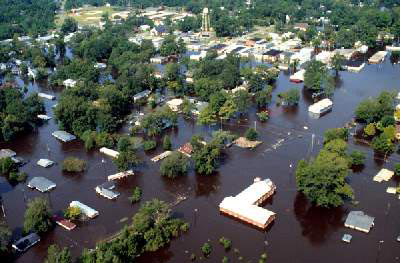
Hurricane Floyd flooded many North Carolina coastal cities, causing damage and public health concerns. (Photo: By U.S. Army Corps of Engineers; Wikimedia Commons)
DYKSTRA: But on this vital issue, the U.S. may be falling behind the Canadians.
CURWOOD: Alright, let’s move on to the environmental history library now. What have you got for us?
DYKSTRA: This week marks the fifteenth anniversary of a hurricane we don’t much remember, it’s but one that left an impact that can be seen, and smelled, to this very day. Hurricane Floyd came ashore near Cape Fear, North Carolina, in 1999. It had already done a lot of damage in the Bahamas, but at its U.S. landfall, it was only a category two storm. Nothing to sneeze at, but far from the worst of storms.
CURWOOD: So what was there to fear from Hurricane Floyd?
DYKSTRA: Hurricane Floyd hit Carolina a week after Hurricane Dennis had left six inches of rain there, and then Floyd came in and pretty much parked over North Carolina, leaving a couple feet of rainfall over a few days. When the skies cleared, it got worse, as North Carolina’s rivers rose, killing 51 people and a couple of million farm animals. Floyd delivered on warnings that the state’s huge and growing hog farming business was verging on a waste-based disaster, and Floyd’s rains overwhelmed the huge lagoons of hog and poultry waste, ruining water supplies and ruining waterways for months.
CURWOOD: The Hog Waste Crisis was a big story. It’s never good when you can smell your wake-up call.
DYKSTRA: Precisely. The stink that was literally raised after Floyd has seen some improvements in how massive livestock farms deal with their waste, but critics say there’s still a big problem.
CURWOOD: Well, thanks Peter. Peter Dykstra is the publisher of Environmental Health News, that's EHN.org, and DailyClimate.org. And there’s more on these stories at our website LOE.org. Talk to you soon Peter!
DYKSTRA: Thanks a lot, Steve. Talk to you soon.
Related links:
- Read the study on how residential green spaces affect birth outcomes in the journal of Environmental Health Perspectives
- Learn more about how the request to interview a Canadian government scientist about rock snot sparked 110 pages of government emails
- Hurricane Floyd flushes out animal waste from North Carolina farms threatening public health and water supplies
[MUSIC: The Beatles “Little Piggies” from The White Album (Apple Records 1968)]
CURWOOD: Coming up: A new, improved organic way to get rid of weeds with a sandblaster. That's just ahead on Living on Earth. Stay tuned.
ANNOUNCER: Funding for Living on Earth comes from United Technologies, a provider to the aerospace and building systems industries worldwide. UTC Building & Industrial Systems provides building technologies, and supplies container refrigeration systems that transport and preserve food and medicine with brands such as Otis, Carrier, Chubb, Edwards and Kidde. This is PRI, Public Radio International.
[CUTAWAY MUSIC:John Coltrane: “Equinox” from Coltrane’s Sound (Atlantic 1964)]
British Petroleum Guilty of Gross Negligence
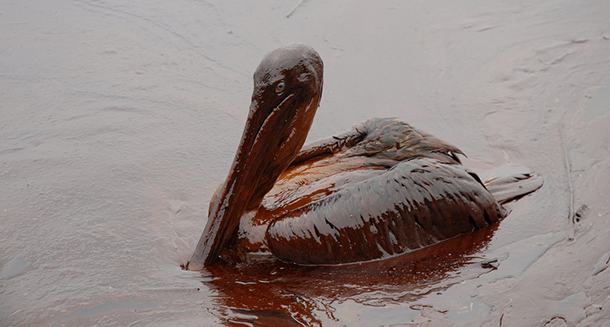
A brown pelican covered in oil as a result of the BP Deep Horizon oil spill. (Photo: Courtesy of Governor Jindal’s office/Louisiana GOHSEP; Flickr CC BY-SA2.0)
CURWOOD: It's Living on Earth. I'm Steve Curwood. A federal judge in Louisiana has found that the oil company BP acted with “gross negligence” in the case of the 2010 Gulf oil disaster, which could lead to fines of as much as $18 billion dollars on top of what BP has already paid. Pat Parenteau is a Professor of Environmental Law at Vermont Law School. He’s just returned from New Orleans, and we called him up to talk about the 120-page ruling from U.S. District Judge Carl Barbier. Welcome back to Living on Earth, Professor.
PARENTEAU: Thank you, Steve. Good to be back.
CURWOOD: So specifically, what the judge mean by "gross negligence" here?
PARENTEAU: Well, he used the word "reckless" and he pointed to a number of things that BP employees did or failed to do leading up to the disaster. And one event in particular was quite dramatic: Thirty-six minutes before the explosion, there were two BP employees on the phone, one on the rig, one in Houston, and they were looking at the pressure tests for the Macondo well. And the man on the rig said, "These numbers look squirly to me." But neither of these two individuals decided to retest the well, and the judge said that was the critical moment to have avoided the disaster.
CURWOOD: And what risks do the individuals involved run?
PARENTEAU: Well, both of these individuals have actually been charged with manslaughter, so their criminal trials are still underway.
CURWOOD: I gather “gross negligence” affects the penalties in a case like this. How does that work?
PARENTEAU: Right. So under the Clean Water Act, simple negligence results in a penalty of roughly $1,000 dollars per barrel of oil spilled. For gross negligence, the penalties are enhanced four-times to roughly $4,000 per barrel.
CURWOOD: So how does all that math affect what BP is going to have to pay?
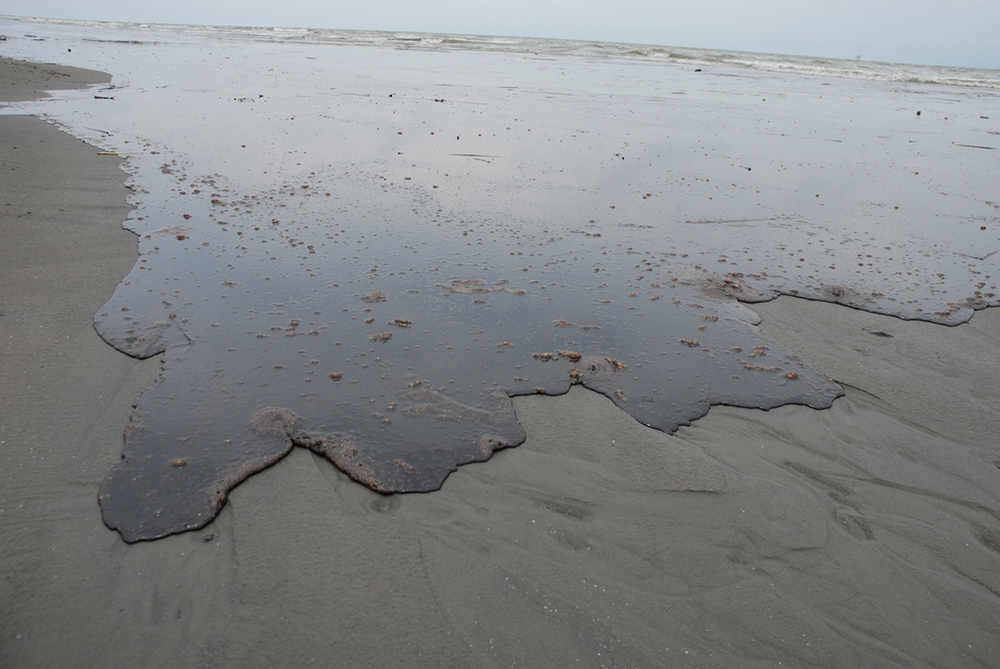
Thick oil washes ashore Louisiana’s coast. (Photo: Courtesy of Governor Jindal’s office/Louisiana GOHSEP; Flickr CC BY-SA 2.0)
PARENTEAU: Well, the government claims that over four million barrels of oil went into the Gulf. BP claims it was closer to two and a half million barrels. Under the government's calculation, under the gross negligence finding of the judge, the maximum penalty would be $18 billion. Under BP's analysis or calculation it would be closer to $10 billion.
CURWOOD: So the judge has found BP liable for this, but now needs to figure out just what the penalty should be.
PARENTEAU: Correct. First he's got to determine what's the right figure in terms of barrels of oil that went into the Gulf, and then he has to apply a series of factors that are required by the Clean Water Act to determine what the final penalty would be.
CURWOOD: Of course, when all that happens, I'm assuming that BP will then appeal the ruling. Where could this case go from there?
PARENTEAU: Right. In fact, BP is probably going to try to appeal right away, even before there's a trial on the amount of damages. They'll take the liability ruling up to the Fifth Circuit Court of Appeals and argue that the judge misapplied the legal standard for what constitutes “gross negligence”. BP's arguing it's more like intentional and knowing and foreseeable acts, and the government is saying in light of the consequences of the spill, the failure to perform some of these critical tests on the well constitutes a lack of the kind of care that should be required when you're dealing with something as dangerous as the situation. So there's a real argument here about what exactly this term "gross negligence" means in the context like this. That's something the Court of Appeals could disagree with the District Court on, so we'll have to wait and see.
CURWOOD: Now, if you were defending BP, what would you think of the judge saying that the company's behavior had been reckless here?
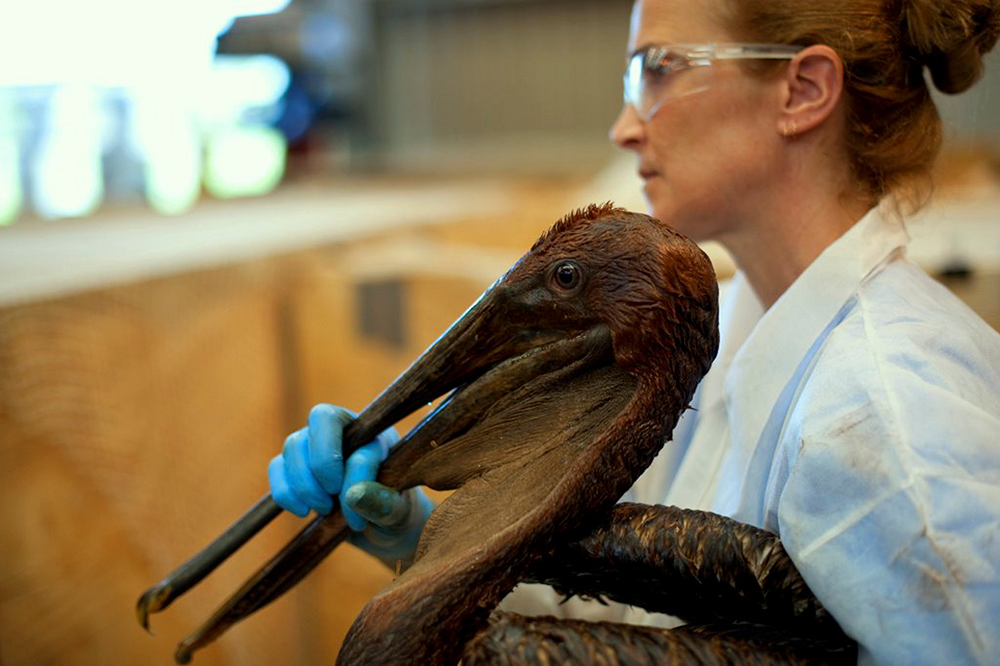
A brown pelican is washed in the aftermath of the BP spill. (Photo: Brian Epstein/International Bird Rescue Research Center; Flickr CC BY 2.0)
PARENTEAU: BP's lawyers say, of course, that their conduct wasn't reckless. I think they're going to say that they had a test in front of them showing that the well was safe to operate, and it was only later that it was determined that that test was basically what you call a false positive: that in fact the well was not secure. And so the BP lawyers are arguing you're kind of doing a Monday morning quarterback on us. You're looking back in time at what happened literally minutes before the explosion, and you can't charge us with recklessness in a situation like that.
CURWOOD: $18 billion dollars. What does that mean to a company like BP? How much would it hurt?
PARENTEAU: Well, their share price declined by six percent with the announcement of this decision. It sounds like a lot of money, but I can't believe it threatens them with bankruptcy. You know, BP is obviously a major global company, and they had set aside $43 billion as a sort of total figure for all the different settlements they're involved in. There's still a natural resource damage case that hasn't concluded yet. They've settled with a number of the parties who were injured, but not all of them. They paid at least one criminal penalty, but now the looking at this other Clean Water Act penalty. So it's looking as if the figure that they thought they were going to be able to resolve this disaster with is not going to be enough money, but to a company like BP even an $18 billion dollar penalty is not really that dramatic.
CURWOOD: Pat, it already feels like this case is been going on for ages, the well blew out four years ago. How long before any of this money comes in?
PARENTEAU: Ultimately if we're talking about penalty amounts in the billions, certainly $18 billion that the government is seeking, BP will take that all the way to the Supreme Court just the way Exxon Mobil did with the Exxon Valdez case, and so ultimately the Supreme Court will have to decide whether whatever penalty figure is finally settled on is reasonable and within the discretion of the lower court. So it will take years, I think, before the dust settles on this.
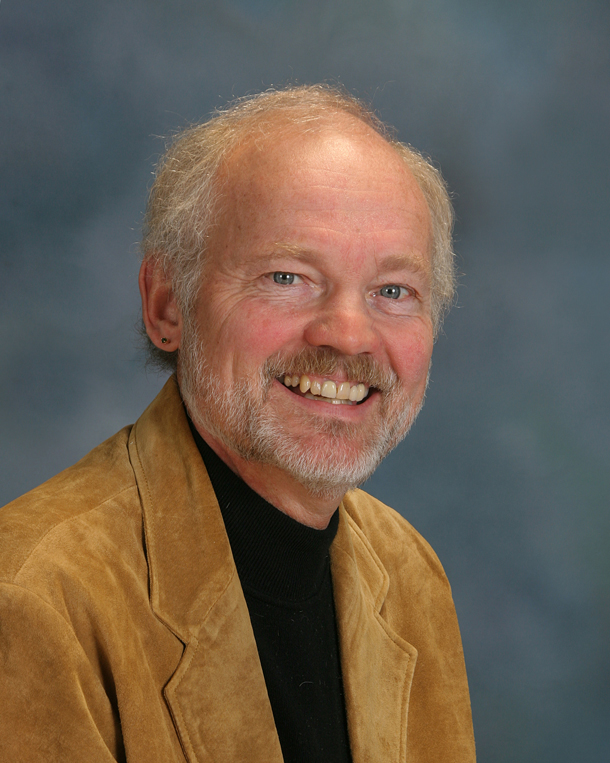
Law Professor Pat Parenteau (Photo: Vermont Law School)
CURWOOD: Speaking of timing, how long was it before Exxon paid for the Exxon Valdez disaster in Alaska, and what portion of the award did the people actually finally receive?
PARENTEAU: Yes, so that was a $5 billion dollar award, and it took about almost a decade to get to the Supreme Court. And the Supreme Court chopped it all the way back to about $500 million and, of course, some of the claimants in the cases which were fishermen had actually died by the time the Supreme Court finally resolved the case, so they never saw any money. So it took an awful long time and it was much less than what people had been hoping for.
CURWOOD: How would this penalty money be used, assuming that the government eventually collects something?
PARENTEAU: Well, a lot of it's going to be used to restore some of the coastal wetlands and barrier islands that I saw when I was down there last week, at least that's what the officials in the state of Louisiana are hoping. Louisiana bore the brunt of the impact, of course, but also Mississippi and Alabama. And so a lot of this is going to have to go to restore oyster beds and barrier islands and wetlands as a way of trying to rebuild the fisheries that were impacted by this.
CURWOOD: How's the ecosystem doing, given the delay to get justice?
PARENTEAU: Well you know they keep finding these strange occurrences: the shrimp that don't have eyes, and dolphins washing up on the beach with great big lesions. So, you know, it takes a long, long time for the full effects of all these - not only the oil but the chemicals that were used to disperse the oil - all of that's working its way through the food chain, so we might not ever get to a point where we have a complete understanding of all the damage that was done to the ecosystem. But the courts are going to have to go ahead and make decisions probably before we find out everything.
CURWOOD: Overall how effective do you think our legal system is at dealing with these kinds of massive ecological disasters?
PARENTEAU: Well, dealing with them after the fact is not adequate, and we're drilling these wells in deeper and deeper water further off the Gulf. BP is been allowed to open new wells in the Gulf of Mexico. As long as we continue this reliance on oil, we're going to have these disasters, hopefully nothing as bad as this one, but oil spills and blowouts are chronic with this industry, and unless we get serious about transforming to cleaner, safer sources of energy, we're constantly facing a risk of disasters like this.
CURWOOD: Pat Parenteau is Environmental Law Professor at Vermont Law School. Thank you for joining us.
PARENTEAU: Thanks, Steve. Appreciate it.
Related links:
- Judge Carl Barbier's full ruling
- Background on the Deepwater Horizon oil spill
- Patrick Parenteau’s page
- More about the Exxon Valdez oil spill in Alaska
[MUSIC: Mamou, “Ugly Day Stomp” from Cajun Magic, Instrumentals from Louisiana (Rounder Records 1998)]
Organic-Friendly Weed Blaster
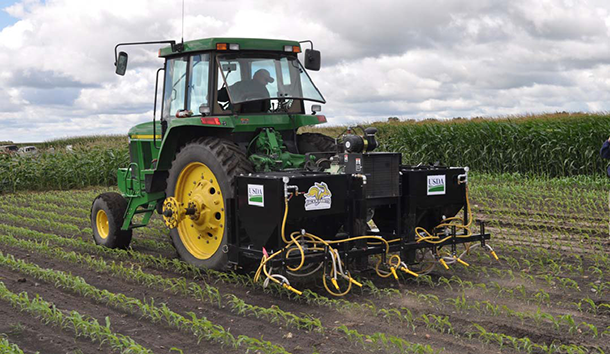
The four-row grit applicator in action, driven by Charles Hennen. (Photo: Frank Forcella)
CURWOOD: If you’ve ever weeded a garden, you know it’s a backbreaking job, and if you have row upon row of crops, it's, well, it’s easier to use herbicides. But then the crop is not organic. Enter a team of soil scientists for the U.S. Department of Agriculture who harnessed a common tool of the building trades to blast away those unwanted weeds without chemicals. Joining me to explain this breakthrough is Frank Forcella. He’s an Agronomist with the USDA’s North Central Soil Conservation Research Laboratory. Welcome to Living on Earth!
FORCELLA: Thanks, Steve. It’s a pleasure to join you.
CURWOOD: So where did this idea to just simply blast weeds to pieces come from?
FORCELLA: Well, one of my hobbies here in Minnesota is growing apricots, and 2007 happened to be a wonderful year for apricot production in Minnesota. And we ended up with about a five gallon bucket worth of apricot pits, and I was wondering what can we do with apricot pits. And one of the things you can do with them is to grind them up and use then as a grit in sandblasters, and I was talking about that with one of the fellows who works with me, Dean Peterson, on our way out to our field plots. Both of us work on weeds, and we had more or less simultaneously had the idea, "I wonder if you could use sandblasters to kill weeds". Initially we thought that had to be the dumbest idea in the world, but it was one of those ideas we just couldn't get out of our heads.
CURWOOD: The light bulb moment for you guys, huh?
FORCELLA: It was a light bulb moment and then we dimmed that light bulb for a while because we thought, well, who knows how much a sandblaster costs, it's probably thousands of dollars. As it turns out, you can buy a very cheap sandblaster for about $50 dollars, so we invested in one of those. The other piece of equipment you need is an air compressor, and we have several air compressors at our lab. And the easiest type of grit to get that point was ground-up walnut shells, and we had some small experiments in our local greenhouse where we grew some weeds in pots next to a corn plant. And then when the corn plant was maybe six inches tall and the weeds were maybe 1 to 3 inches tall, we would start hitting them with split-second applications of walnut shell grit.
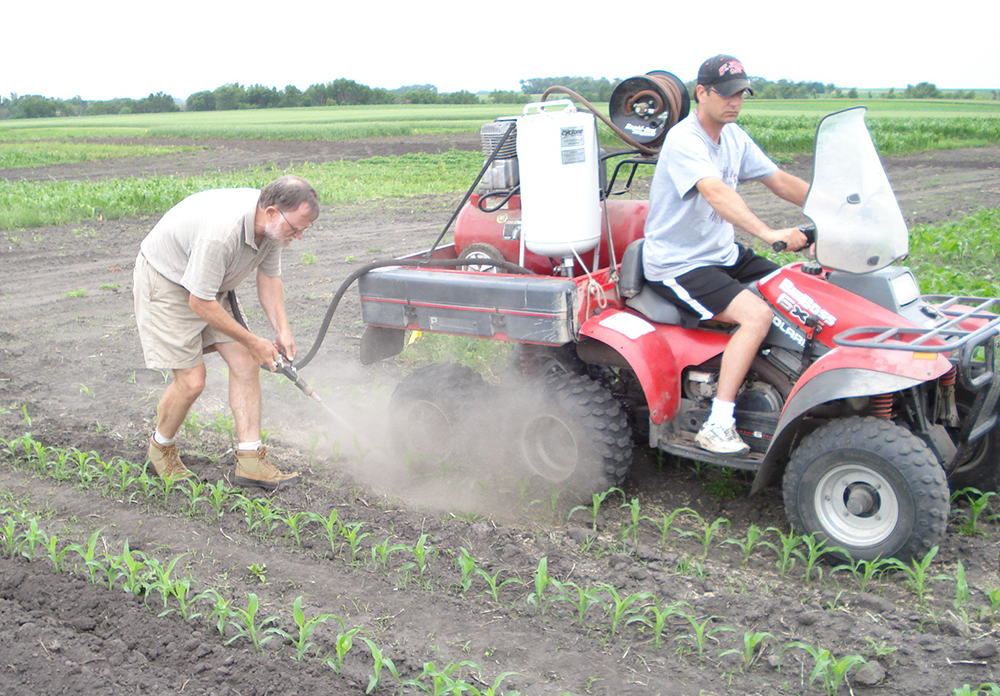
Jim Eklund and Frank Forcella conduct an early test of the concept with a single-nozzle blaster. Jim is driving ATV and Frank applying the grit. (Photo: Courtesy of Frank Forcella)
CURWOOD: And what did you find?
FORCELLA: Well, the weeds would simply disappear and the corn plant remained intact. Then we decided, well let's try this out in the field, and so we bought a bigger sandblaster. And we mounted that on a small ATV, and Dean would be driving the ATV and he would make me hold the nozzle for the sandblaster. And I would follow the ATV in a stooping position, blasting small weed seedlings they were growing alongside corn plants.
CURWOOD: So who might be interested in a system like this?
FORCELLA: The primary users would be organic farmers. Weeds are one of the most contentious issues for organic farmers. They have very few other tools in their toolboxes that they can use for weed control, and so they are desperate for alternative forms of weed management. Lots of the tools that organic farmers have are related to soil disturbance: plowing, tilling, disking and so forth, all of which work, but they have environmental consequences, like soil erosion, like CO2 loss from the soil and so forth.
CURWOOD: What do you think is the best material to use for grit when you want to blast weeds?
FORCELLA: If the material has a gritty texture to it, it can be used for weed control with a sandblaster. The most typical one and the most commonly available grit material that is used by professional sandblasters is corncob grit. Now when we've talked to organic farmers about this, they said “well that's interesting, but we probably wouldn't use corncob grit on our own farms, not because it doesn't work, but because it doesn't have an alternative value aside from adding organic matter to the soil”. What they prefer and what their suggestion was, was to use organically approved fertilizers that also have a gritty texture to them, to control weeds as well as fertilize the crops. For example, corn gluten meal, which is very rich in nitrogen. It has a gritty texture and it works just fine as a grit for weed control. But there are many other types of grit too: cottonseed meal, canola seed meal, alfalfa pellets and even crushed limestone that almost every farmer who has acidic soils has to add limestone to their soil, and if they're going to do that, they might as well use it in a gritty form and apply it at the time they have to control weeds.
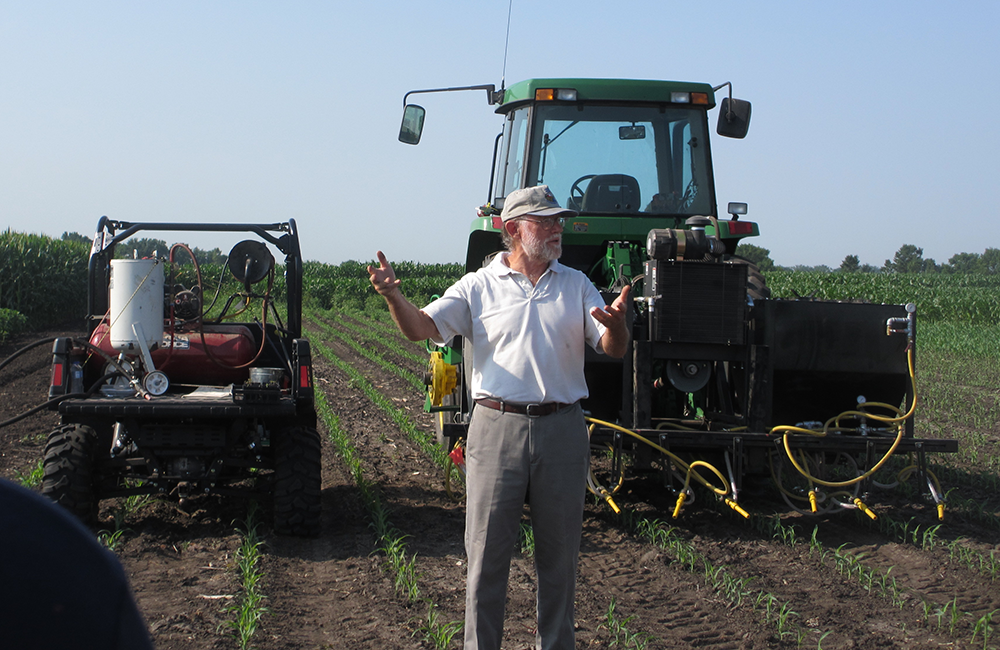
Frank Forcella demonstrates the potential of the Weed Blaster at the University of Minnesota’s West Central Research and Outreach Center. The concept-testing rig is on the left, and PAGMan on the right. (Photo: Courtesy of Frank Forcella)
CURWOOD: Now, what kind of crops can you use this technique on?
FORCELLA: To date, we have been applying this material on both corn and soybean in our experiments, and it has worked well on both of those crops. Professor Sam Wortman has taken up this initiative in Illinois, and he's been using it in tomato and having great success in tomato as well.
CURWOOD: Now, how precise is this blasting? I mean what's the damage of taking out the crop you're trying to protect?
FORCELLA: So, when the grit is coming out of these nozzles, we get a pattern about 3 to 4 inches wide on either side of the crop row, as well as in the crop row itself, but we're not actually applying the grit to the crop plant, just at the very base of the crop plant. And so very little damage is occurring to the crop plant, but the small weeds are growing alongside it are, more or less obliterated.
CURWOOD: How cost-effectiveness is this technique?
FORCELLA: So it may cost $100 dollars or more per acre for weed control. That seems expensive, but if you consider the fact that we can use organically approved fertilizers as a grit for weed control, that reduces the cost immensely. This is all in experimental stages and we assume we can become much more efficient in the future. And along those lines we have collaborators now in Spain, as well as University of Illinois and the University of California, Davis, trying to develop the method to improve its efficiency, not just in vegetable crops, but also in vineyards and olive orchards to make the applications more precise—so adding GPS units so we can get precision application of the grit, as well as providing robotic control, so you don't actually need a human out there.
CURWOOD: So, Frank, a while back you and your partner were out there, maybe a bit like 10-year-olds riding ATVs, spraying things around in the fields. Now that this is official, is the fun still there?
FORCELLA: Actually, yes it is, in fact, it's getting even better. The National Institute of Food and Agriculture has just funded another grant; the Spanish government is funding yet another project all along these lines. We think it's starting to snowball, and we are very encouraged.
CURWOOD: Well, I'll be looking forward to having my first taste of crops grown with the Forcella weed blaster.
FORCELLA: [LAUGHS] Thanks, Steve.
CURWOOD: Frank Forcella is a Research Agronomist with the U.S. Department of Agriculture in Morris, Minnesota. Thanks so much, Frank.
FORCELLA: You’re welcome.
Related links:
- Read Forcella's abstract.
- More on Weed Blaster research and potential via the Minneapolis StarTribune
BirdNote® Bushtit - A Very Tiny Songbird

Smaller than a hummingbird, bushtits are mostly brown, social songbirds, weighing as much as about four paperclips. (Photo: Rick Leche/BirdNote®)
[MUSIC: BIRD NOTE® THEME]
CURWOOD: If you’re turning your eyes to the skies at this time of year, you’ll notice many birds gathering together to plan a trip to warmer weather. But as Mary McCann explains in today’s BirdNote®, some birds don’t fly away. As the saying goes, they just flock together.
BirdNote®
Bushtit - A Very Tiny Songbird
[BUSHTIT CALLS]
Only a few songbirds anywhere in the world are as small as Bushtits. Weighing in at 5.3 grams – that’s about the weight of four paperclips – they are smaller than many hummingbirds. Take a close look at a Bushtit, and you’ll marvel at how tiny it is.
[BUSHTIT CALLS]
But Bushtits take full advantage of their diminutive size. While larger insect eaters forage on the upper surfaces of leaves and twigs, Bushtits hang beneath them. That gives them exclusive access to all the tiny insects and spiders protected from the rain and hiding out of sight of other birds. Watch a foraging flock of Bushtits, and you’ll have to smile. A shrub or small tree may be full of little brown, long-tailed birds hanging upside-down like Christmas-tree ornaments.
[BUSHTIT CALLS]
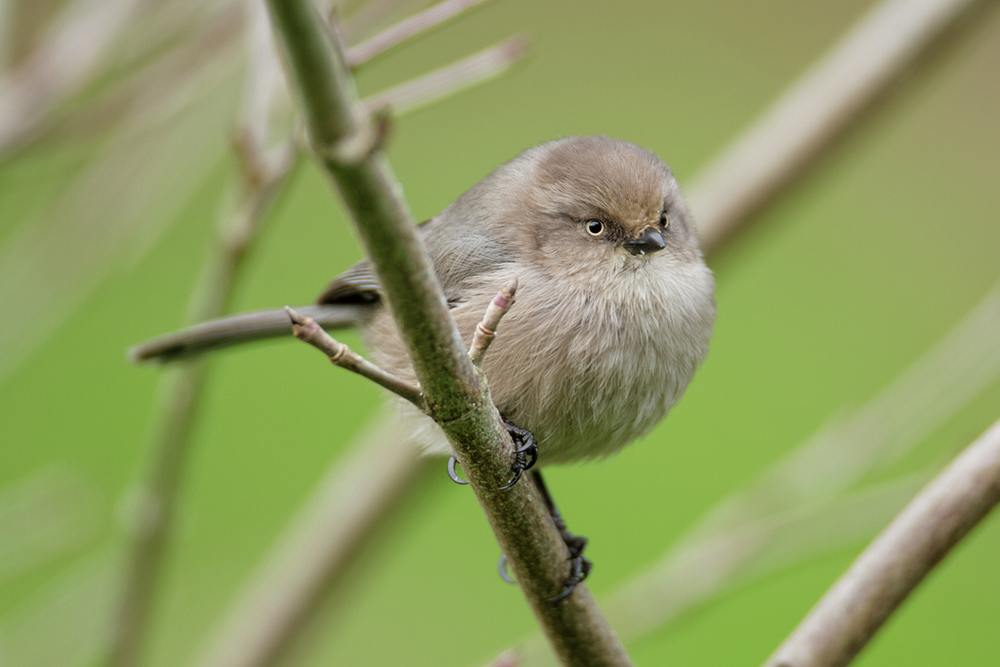
Bushtits are plump birds with a large head and long tails, and they chirp softly. (Photo: Rick Cameron/BirdNote®)
After they finish nesting, Bushtits go about in flocks of 30 or more. One bird after another flies from bush to bush, like a troop passing in review. Their quiet calling helps them keep track of one another.
Where they live in suburbia, a flock of 30 Bushtits can do a great job of ridding a garden of harmful aphids and scale insects. Good things do come in small packages!
[BUSHTIT CALLS]
I’m Mary McCann.
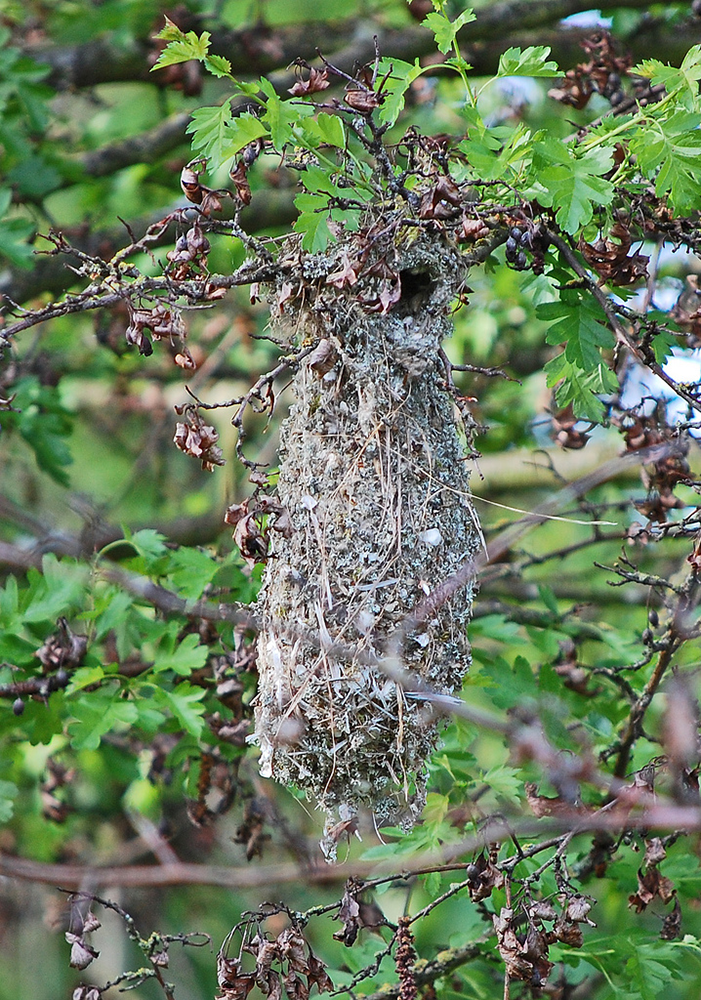
Bushtits live in forests, woodlands and suburbs, weaving unusually shaped nests from grass, spider webs and moss. (Photo: Alexandra MacKenzie/ BirdNote®)
Written by Dennis Paulson
Vocalizations Bushtits provided by The Macaulay Library of Natural Sounds at the Cornell Lab of Ornithology, Ithaca, New York. Calls of flock [120213] recorded by G.A. Keller.
BirdNote's theme music was composed and played by Nancy Rumbel and John Kessler.
Producer: John Kessler
Executive Producer: Chris Peterson
© 2014 Tune In to Nature.org May 2014 Narrator: Mary McCann
http://birdnote.org/show/bushtits
CURWOOD: For some photos of tiny Bushtits, flit on over to our website LOE.org.
Related link:
Listen to more Bushtit pieces on the BirdNote® website.
CURWOOD: Living on Earth is produced by the World Media Foundation. Naomi Arenberg, Bobby Bascomb, Emmett Fitzgerald, Helen Palmer, Adelaide Chen, Lauren Hinkel, Jake Lucas, and Jennifer Marquis all help to make our show. We welcome Jenni Doering to our team this week. Jeff Turton is our technical director. James Curwood engineered today’s show with special thanks to Noel Flatt. Alison Lirish Dean composed our themes. You can find us anytime at LOE.org - and like us on our Facebook page - it’s PRI’s Living on Earth. And we tweet from @LivingOnEarth. I'm Steve Curwood. Thanks for listening.
ANNOUNCER1: Funding for Living On Earth comes from the Grantham Foundation for the protection of the environment, supporting strategic communications and collaboration in solving the world’s most pressing environmental problems. The Kendeda Fund, furthering the values that contribute to a healthy planet, and Gilman Ordway for coverage of conservation and environmental change. Living on Earth is also supported by Stonyfield Farm, makers of organic yogurt, smoothies and more. www.stonyfield.com.
ANNOUNCER2: PRI. Public Radio International.
Living on Earth wants to hear from you!
Living on Earth
62 Calef Highway, Suite 212
Lee, NH 03861
Telephone: 617-287-4121
E-mail: comments@loe.org
Newsletter [Click here]
Donate to Living on Earth!
Living on Earth is an independent media program and relies entirely on contributions from listeners and institutions supporting public service. Please donate now to preserve an independent environmental voice.
NewsletterLiving on Earth offers a weekly delivery of the show's rundown to your mailbox. Sign up for our newsletter today!
 Sailors For The Sea: Be the change you want to sea.
Sailors For The Sea: Be the change you want to sea.
 The Grantham Foundation for the Protection of the Environment: Committed to protecting and improving the health of the global environment.
The Grantham Foundation for the Protection of the Environment: Committed to protecting and improving the health of the global environment.
 Contribute to Living on Earth and receive, as our gift to you, an archival print of one of Mark Seth Lender's extraordinary wildlife photographs. Follow the link to see Mark's current collection of photographs.
Contribute to Living on Earth and receive, as our gift to you, an archival print of one of Mark Seth Lender's extraordinary wildlife photographs. Follow the link to see Mark's current collection of photographs.
 Buy a signed copy of Mark Seth Lender's book Smeagull the Seagull & support Living on Earth
Buy a signed copy of Mark Seth Lender's book Smeagull the Seagull & support Living on Earth

